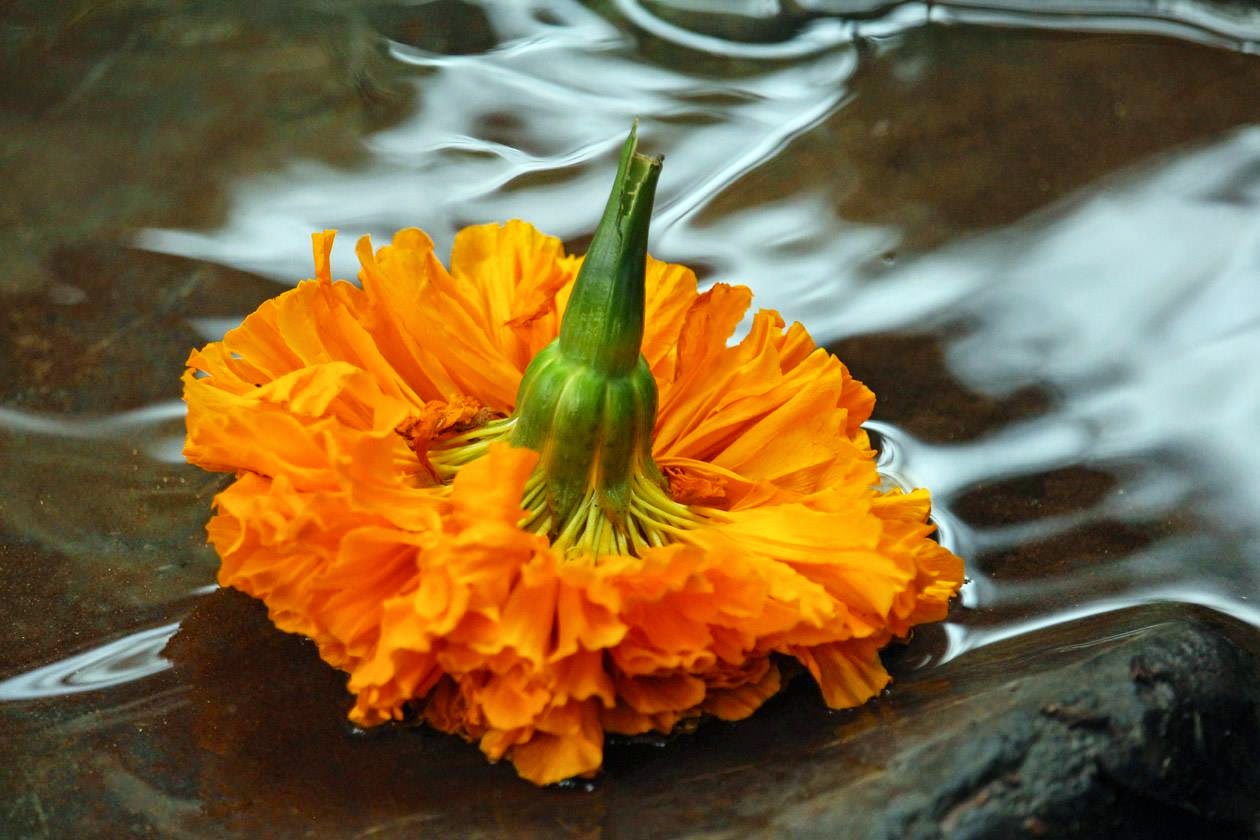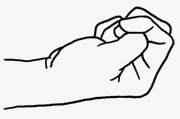by Beth Gibbs, MA, E-RYT 500
 |
| Marigold and Water by Melina Meza |
From the yogic perspective, menopause is a moving away from a more rajasic (active) time of life towards a more sattvic (contemplative) time of life—a transition from the Householder to the Forest Dweller stage of life. This view of the female human life span is supported by many western writers and thinkers, such as, Christiane Northrup, Susan Lark and Susun Weed, who have written books about the experience of menopause. They all point to the urge or drive, which often occurs during the menopausal years, that can move women to begin the inner journey, address unfinished business, and claim the wisdom and power potentially inherent in this time of their lives. Each woman’s menopause experience is like a fingerprint—one of a kind, unique and personal. Yoga, therefore, is an excellent companion on this path, both to aid the journey and to help manage symptoms.
This post will address hot flashes, a common physical symptom experienced by many women during the menopausal transition. Christiane Northrup, M. D., defines a hot flash this way in her book The Wisdom of Menopause: Creating Physical and Emotional Health During the Change:
“Also known as vasomotor flushing, the hot flash occurs when the blood vessels in the skin of the head and neck open more widely than usual, allowing more blood to shift into the area, creating heat and redness.”
Typically triggered by falling estrogen levels during peri-menopause, hot flashes usually stop a year or two after the actual menopause date, which is determined retroactively, after a full year without a period. However, in some cases women may experience hot flashes for years. Hot flashes often start with a sense of warmth, which can escalate to feelings of intense heat usually felt in the scalp, face and chest area. A flash may also be accompanied by tingling, nausea, increased heart rate, or perspiration. Over time, if not addressed or treated, hot flashes may result in depression and sleep deprivation.
Hot flashes can be mild or severe and their duration can be influenced by external factors, such as diet or a woman’s reaction or response to stress. In general, it is thought that the higher a woman’s stress levels are in response to stressful events, the more hot flashes she may have or the more intensely she may experience hot flashes. Conversely, the more effectively a woman handles stressful situations, the more likely she is to experience milder hot flashes or have less intense reactions to them.
Of course, yoga postures, breathing practices, and meditation are all effective methods of stress reduction and management (see The Relaxation Response and Yoga). And forward bends, classic or modified, are typically recommended to calm, cool, and relax a body under stress (see Supported Forward Bends: Peaceful Poses). As a yoga therapist, I recommend that anyone dealing with stress from any source, find a way to incorporate a regular well-rounded yoga practice, including asana, pranayama, relaxation and meditation, several times a week into their lives.
That said, hot flashes cay still occur, anytime, anywhere and under any circumstances. Therefore, I advise women who are experiencing hot flashes to have a couple of “off the mat” yoga techniques at hand that can be done anytime, anywhere and under any circumstances. Pranayama (yoga breathing techniques) and mudras (hand gestures) can help with the physical goals of cooling the body as well as the energetic goals of calming the mind and grounding emotional states. With practice you may be able to reduce the occurrence and intensity of hot flashes, and begin to restore a sense of control to a time of life that can often feel uncontrollable.
Cooling Breath
The Cooling Breath is a modified version of Sitali Pranayama, and can be done anytime, anywhere. This breath practice will often stop a hot flash if you can catch it just as it begins. If you can, practice the Cooling Breath regularly so that it is readily available when you feel a hot flash coming on.
Instructions:
- Sit (or stand) in a comfortable position with your spine straight.
- Open your mouth, purse your lips like you were going to whistle and slowly draw cool air in over your tongue and into your lungs.
- Close your mouth and exhale slowly through your nose.
- Repeat for as many times as you like and as often as needed.
You can also practice the Cooling Breath in bed if you have hot flashes during the night.
Adhi Mudra

The Sanskrit word adhi means “primordial” and refers to our natural state of being, our truest nature from the yogic perspective. The gesture is said to bring the breath to the base of the body, help with anxiety, and instill a deep sense of grounding and stillness. According to Joseph and Lilian LePage in Mudras for Healing and Transformation, Adhi Mudra slows the breath and lengthens the exhalation, which reduces heart rate and blood pressure.” Practice Adhi Mudra regularly so it is second nature when you find yourself experiencing a hot flash or in a stressful situation.
Instructions:
- Sit comfortably with your spine straight.
- Soften your chest and shoulders.
- Close your eyes or keep them slightly open and gaze down at the floor.
- With both hands, form soft fists by placing your thumbs across your palms and folding your fingers around your thumbs (Adhi Mudra).
- Rest your hands, knuckles down, on your knees or thighs.
- Hold the mudra and sit quietly for 2 – 5 minutes as long as you are comfortable.
- Focus on your natural breathing process. Or, if you like, you can practice the Cooling Breath while practicing Adhi Mudra.
- When you are ready to come out, release the mudra and stretch your body in any way that your body needs to stretch.

Beth Gibbs, MA, E-RYT 500, is a certified yoga therapist through Integrative Yoga Therapy. She is a senior member of the IYT teaching faculty and directs the school’s Professional Yoga Therapist Internship Program. Beth has a Masters degree in Yoga Therapy and Mind/Body Health from Lesley University in Cambridge, MA, and has served on the Educational Standards Committee for the International Association of Yoga Therapists. Her website is: www.proyogatherapeutics.com
Follow Yoga for Healthy Aging on Facebook ° To order Yoga for Healthy Aging: A Guide to Lifelong Well-Being, go to Amazon, Shambhala, Indie Bound or your local bookstore.


I love this post and thanks for introducing me to Beth. I'm planning on writing a blog on menopause and how Ayurveda views this issue. I would love to make mention of this post in my blog if that's okay.
Glad you love this post. And, of course, you can mention this article. Please include a link back to the original article on our blog, if possible. Thanks!